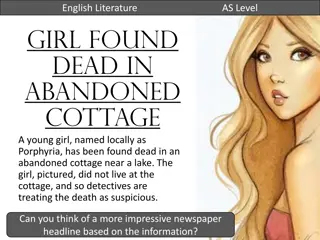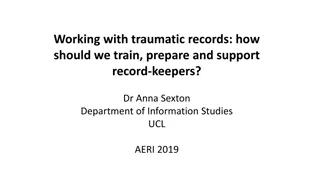Life at Lock Keepers Cottage - A Glimpse into History
Fascinating life of lock keepers at the Lagan Navigation Company, their humble cottage living arrangements, and the memories shared by Dorothy Kilpatrick. Discover the unique stories of hard work, family, and daily life in this charming historical setting.
Download Presentation

Please find below an Image/Link to download the presentation.
The content on the website is provided AS IS for your information and personal use only. It may not be sold, licensed, or shared on other websites without obtaining consent from the author.If you encounter any issues during the download, it is possible that the publisher has removed the file from their server.
You are allowed to download the files provided on this website for personal or commercial use, subject to the condition that they are used lawfully. All files are the property of their respective owners.
The content on the website is provided AS IS for your information and personal use only. It may not be sold, licensed, or shared on other websites without obtaining consent from the author.
E N D
Presentation Transcript
Lock Keepers Cottage www.laganvalleylearning.co.uk www.laganvalleylearning.co.uk
Lock keepers The Lagan Navigation Company, who owned the canal, employed them and they were given houses to live in beside the locks as part of the job. Lock keepers were the men who looked after the locks and made sure that the boats got through safely. George Kilpatrick became the Lock Keeper at Lock 3 in 1922.
The lock keepers family Mum Children Dad This is a picture of Dorothy and two of her sisters sitting on part of the lock gate. Dorothy (age 9) is on the left. She has given us some lovely memories of life in the cottage. This is a picture of Mrs Kilpatrick with one of her grandchildren. This is George Kilpatrick. He was the lock keeper at lock no.3.
Inside the lock keepers family The Lock Keeper lived in the cottage with his wife and 10 children. This was Mr and Mrs Kilpatrick s bedroom. It was found on the ground floor of the cottage. It was also used as the good room when important people came to visit. These stairs led to two bedrooms. The six girls shared one room and four boys shared the other. This tin bath was used for washing the clothes and for washing the people!
Dorothys memories of the cottage There was no electric, my mother cooked on the fire, a big open fire. My father was allowed coal off the boats; that was one of the perks, massive lumps of coal thrown off the barge that he had to cut up. There were two hobs, one either side of the fire. The kettle was always on one, the tea pot on the other. There was a big fender at the front and that was where she kept the plates warm . She had a griddle, she baked every morning, before we were out of our beds she would have soda bread, potato bread and wheaten bread baked. How she ever did it, I will never know, she never seemed to be exhausted . For essentials we were sent to bring messages - that was what it was called, you went for messages never for groceries at the shop at Milltown, Fairweathers it was called.
Dorothys memories of the garden Dorothy was the daughter of Mr Kilpatrick she said; My father was a lock keeper, he kept a few animals and looked after the garden. The wages were not very high so he had to grow his own vegetables and we had two goats for milk. My mother had hens and two or three geese . These are some of the fruit and vegetables grown in the garden. Can you name them?
The lean-to shop To the side of the lock house was the shop. It had a sloping corrugated roof. My father ran the shop as another way of making a bit of money . The shop sold The shop was open every day but Saturday and Sunday were big days. At that time people walked more than they do now and courting couples would walk the towpath.
www.laganvalleylearning.co.uk www.laganvalleylearning.co.uk























